We have given these Important Questions for Class 10 Science Chapter 11 Light Reflection and Refraction to solve different types of questions in the exam. Previous Year Questions & Important Questions of Light Reflection and Refraction Class 10 Science Chapter 11 will help the students to score good marks in the board examination.
Important Questions of Light Reflection and Refraction Class 10 Science Chapter 11
Question 1.
State one function of iris in human eye. (AI 2012)
Answer:
Irish adark muscular diaphragm that controls the size of the pupil.
Question 2.
State one function of the crystalline lens in the human eye. (Foreign 2012)
Answer:
The crystalline lens of human eye focuses the light that enters the eye and form the image on the retina.
Question 3.
Define the term power of accommodation. Write the modification in the curvature of the eye lens which enables us to see the nearby objects clearly? (Delhi 2019)
Answer:
The ability of the eye lens to adjust its focal length is called power of accommodation. The ciliary muscles modifies the curvature to some extent. The change in the curvature of the eye lens can thus change its focal length. When the ciliary muscles contract, the lens becomes thick and its focal length decreases, thus enables us to see nearby objects clearly.
Question 4.
Trace the sequence of events which occur when a bright light is focused on your eyes. (Delhi 2019)
Answer:
When a bright light enters the eye then most of the refraction for the light rays entering the eye occurs at the outer surface of the cornea. Then, the crystalline lens merely provides the finer adjustment of focal length required to focus object at different distances on the retina. The pupil regulates and controls the amount of light entering the eye. At retina, the light-sensitive cells get activated upon illumination and generate electric signals. These signals are sent to the brain via the optic nerves. The brain interprets these signals and finally, processes the information so that we perceive objects as they are.
Question 5.
Write about power of accommodation of human eye. Explain why the image distance in the eye does not change when we change the distance of an object from the eye? (Delhi 2017)
Answer:
The ability of the eye lens to adjust its focal length is called power of accommodation.
The ciliary musqles modifies the curvature to some extent. The change in the curvature of the eye lens can thus change its focal length. Thus, the focal length of the human lens increases or decreases depending on the distance of the object value to this distance of the image does not change. For example, when the ciliary muscles are relaxed, the lens becomes thin and its focal length increases, thus enables us to see distant object clearly.
Question 6.
State the function of each of the following parts of human eye:
(i) Cornea
(ii) Iris
(iii) Pupil (1.5/3, Delhi 2013 C)
Answer:
(i) Cornea : It is a transparenl bulge on the front surface of eyeball which refracls most ol lhe light rays entering the eye.
(ii) Iris : Refer to answer 1.
(iii) Pupil: It controls the amount of light entering into the eye.
Question 7.
Write the function of each of the following parts of human eye:
(i) Cornea (ii) Iris (iii) Crystalline lens (iv) Ciliary muscles (2/5, 2018, Delhi 2016)
Answer:
(i) Cornea : Refer to answer 6(i).
(ii) Iris : Refer to answer 1.
(iii) Crystalline lens : Refer to answer 2.
(iv) Ciliary muscles: Ciliary muscles holds the eye lens and helps in the adjustment of its focal length.
Question 8.
State the function of each of the following parts of the human eye :
(i) Cornea (ii) Iris (iii) Pupil (iv) Retina (2/5, Foreign 2015)
Answer:
(i) Cornea : Refer to answer 6(i).
(ii) Iris : Refer to answer 1.
(iii) Pupil: Refer to answer 6(iii).
(iv) Retina: It capture light and convert it into electric signals that are translated into images by the brain.
Question 9.
(a) List the parts of the human eye that control the amount of light entering into it. Explain how they perform this function?
(b) Write the function of retina in human eye. (3/5, AI2014)
Answer:
(a) The part of the human eye that controls the amount of light entering into it is pupil.
Light enters the eye through a thin membrane called the cornea. It forms the transparent bulge on the front surface of the eyeball most of the refraction for the light rays entering the eye occurs at the outer surface of the cornea, the crystalline lens merely provides the linear adjustment of focal length required to focus objects at different distances on the retina. Iris which is behind the cornea controls the size of the pupil. The pupil regulates and controls the amount of light entering the eye.
edward
Question 10.
Person suffering from cataract has
(a) elongated eyeball
(b) excessive curvature of eye lens
(c) weakened ciliary muscles
(d) opaque eye lens
Answer:
(d) A person suffering from cataract has cloudy opaque eye lens.
Question 11.
(a) List two causes of hypermetropia.
(b) Draw ray diagrams showing (i) a hypermetropic eye and (ii) its correction using suitable optical device. (2020)
Answer:
(a) Hypermetropia is caused due to following reasons:
(i) Shortening of the eyeball
(ii) Focal length of crystalline lens is too long.
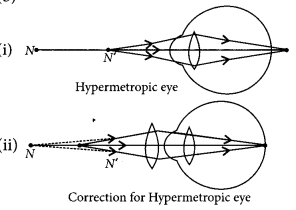
Question 12.
(a) A person is suffering from both myopia and hypermetropia.
(i) What kind of lenses can correct this defect?
(ii) How are these lenses prepared?
(b) A person needs a lens of power +3 D for correcting his near vision and -3 D for correcting his distant vision. Calculate the focal lengths of the lenses required to correct these defects. (2020)
Answer:
(a) (i) The lens which can correct the vision of such a person suffering from both myopia and hypermetropia is a bifocal lens.
(ii) A common type of bifocal lens contains both concave and convex lens. It is prepared with the upper portion consisting of a concave lens facilitating distant vision and the lower portion consisting of convex lens facilitating near vision, (b) The power for correcting his near vision,
P
N
= +3 D.
As P = \(\frac { 1 }{ f(m)}\)
∴ Focal length of convex lens needed,
f
N
= \(\frac { 1 }{ P_N}\) = 0.33 m = +33.33 cm
Power required to correct distant vision, PD = -3D
∴ Focal length of concave lens,
f
D
= \(\frac { 1 }{ P_D}\) = -0.33 m = -33.33 cm.
Question 13.
A person may suffer from both myopia and hypermetropia defects.
(a) What is this condition called?
(b) When does it happen?
(c) Name the type of lens often required by the persons suffering from this defect. Draw labelled diagram of such lenses. (2020)
Answer:
(a) This condition is called presbyopia.
(b) It happens due to gradual weakening of ciliary muscles and diminishing flexibility of eye lens due to agening.
(c) It can be corrected by using bifocal lenses.

Question 14.
What eye defect is myopia? Describe with a neat diagram how this defect of vision can be corrected by using a suitable lens. (AI 2011)
Answer:
Myopia is also known as near-sightedness. A person with myopia can see nearby objects clearly but cannot see distant objects distinctly.
Myopia can he corrected by using concave lens of appropriate local length.
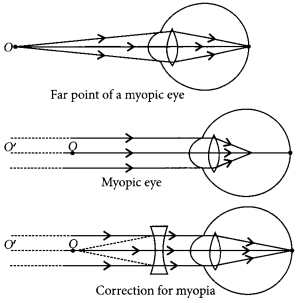
Question 15.
Name the three common defects of vision. What are their causes? Name the type of lens used to correct each of them. (Foreign 2011)
Answer:
Three common defects of vision are
- Myopia
- Hypermetropia
- Presbyopia
mccaffery:
- Elongation of eyeball.
- Excessive curvature of eye lens.
myopia
- Shortening of eyeball.
- Focal length of eye lens becomes too long.
can
be
- Myopia can be corrected by using concave lens of appropriate focal length.
- Hypermetropia can he corrected by using convex lens of appropriate local length.
- Presbyopia can be corrected by using bifocal lens.
Question 16.
A student is unable to see clearly the words written on the black board placed at a distance of approximately 3 m from him. Name the defect of vision the boy is suffering from. State the possible causes of this defect and explain the method of correcting it. (3/5, 2018)
Answer:
Student is suffering from myopia.
The two possible reasons due to which the defect of vision arises are : excessive curvature of the eye lens and elongation of the eye ball.
A student with myopia has the far point nearer than infinity, thus, the image of a distant object is formed in front of the retina.

Correction of myopia: This defect can be corrected by using a concave lens of suitable power as it brings the image back on to the retina, thus the defect is corrected.

Question 17.
A student suffering from myopia is not able to see distinctly the objects placed beyond 5 m.
(a) List two possible reasons due to which this defect of vision may have arisen. With the help of ray diagrams, explain
(i) Why the student is unable to see distinctly the objects placed beyond 5 m from his eyes?
(ii) The type of the corrective lens used to restore proper vision and how this defect is corrected by the use of this lens.
(b) If, in this case, the numerical value of the focal length of the corrective lens is 5 m, find the power of the lens as per the new Cartesian sign convention. (AI 2017)
Answer:
(a) Refer to answer 16.
(b) Focal length, f = -5 m
P = \(\frac { 1 }{ f(in meters)}\) or, p = \(\frac { 1 }{ -5}\) = -0.2D
Hence, the power is – 0.2 D.
Question 18.
Millions of people of the developing countries of world are suffering from corneal blindness. These persons can be cured by replacing the defective cornea with the cornea of a donated eye. A charitable society of your city has organised a campaign in your neighbourhood in order to create awareness about this fact. If you are asked to participate in this mission how would you contribute in this noble cause?
(a) State the objective of organising such campaigns.
(b) List two arguments which you would give to motivate the people to donate their eyes after death.
(c) List two values which are developed in the persons who actively participate and contribute in such programmes. (VBQ, 3/5, Delhi 2016)
Answer:
We can encourage people to participate in the camp and also register ourselves as a donator.
(a) The objective of organising such campaign is to make people aware and realize their duties towards society.
(b) (i) By donating our eyes after we die, we can light the life of a blind person.
(ii) One pair of eyes gives vision to two corneal blind people.
(c) (i) It shows the concern for others.
(ii) It also shows the responsible behavior towards the society.
Question 19.
A student is unable to see clearly the words written on the blackboard placed at a distance of approximately 4 m from him. Name the defect of vision the boy is suffering from.
Explain the method of correcting this defect. Draw ray diagram for the
(i) defect of vision and also
(ii) for its correction (Delhi 2015)
Answer:
Refer to answer 16.
Question 20.
Write the importance of ciliary muscles in the human eye. Name the defect of vision that arises due do gradual weakening of the ciliary muscles in old age. What type of lenses are required by the persons suffering from this defect to see the objects clearly?
Akshay, sitting in the last row in his class, could not see clearly the words written on the blackboard. When the teacher noticed it, he announced if any student sitting in the front row could volunteer to exchange his seat with Akshay. Salman immediately agreed to exchange his seat with Akshay. He could now see the words written on the blackboard clearly. The teacher thought it fit to send the message to Akshay s parents advising them to get his eyesight checked.
In the context of the above event, answer the following questions:
(a) Which defect of vision is Akshay suffering from? Which type of lens is used to correct this defect?
(b) State the values displayed by the teacher and Salman.
(c) In your opinion, in what way can Akshay
express his gratitude towards the teacher and Salman? (VBQ, AI 2015)
Answer:
Ciliary muscles modifies the curvature of eye lens and hence adjusts its focal length. I his enables us to see objects.
The defect of vision arises due to weakening of ciliary muscles in old age is presbyopia, person suffering from this defect should wear bifocal lenses. These lenses consists of both concave and convex lenses.
(a) Akshay is suffering from myopia or near-sightedness. He should use concave lens to correct this defect.
(b) Teacher and Salman are concerned and caring.
(c) Akshay can show his gratitude by saying thank you.
Question 21.
Millions of people of the developing countries are suffering from corneal blindness. This disease can be cured by replacing the defective cornea with the cornea of a donated eye. Your school has organised a campaign in the school and its neighbourhood in order to create awareness about this fact and motivate people to donate their eyes after death. How can you along with your classmates contribute in this noble cause? State the objectives of organising such campaigns in schools. (VBQ, 3/5, Foreign 2015)
Answer:
Refer to answer 18.
Question 22.
Do you know that the corneal-impairment can be cured by replacing the defective cornea with the cornea of the donated eye?
How and why should we organise groups to motivate the community members to donate their eyes after death? (2/5, AI 2014)
Answer:
Yes, we know that the corneal – impairment can be cured by replacing the objective cornea with the cornea of the donated eye. We can provide the importance of eye donation to the community members. Our eyes can live even after our death. By donating our eyes after die, we can light the life of a blind person. The human eye is one of the most valuable and sensitive sense organs. It enables us to see the wonderful world and colours around us. It is however, impossible to identify colours while closing the eyes. Thus of all the sense organs, the human eye is the most significant one as it enables as to see the beautiful colourful word around us. Hence, we should donate our eyes after death.
Question 23.
What is myopia? List two causes for the development of this defect? How can this defect be corrected using a lens? Draw ray diagrams to show the image formation in case (i) defective eye and (ii) corrected eye. (Foreign 2014)
Answer:
Myopia is also known as near-sightedness defect in which a person can see nearby objects clearly but cannot see distant objects distinctly. This defect may arise due to
(a) excessive curvature of the eye.
(b) elongation of the eye ball.
This defect can be corrected by using a concave lens of suitable power.
Refer to answer 16.
Question 24.
(a) A person cannot read newspaper placed nearer than 50 cm from his eyes. Name the defect of vision he is suffering from. Draw a ray diagram to illustrate this defect. List its two possible causes. Draw a ray diagram to show how this defect may be corrected using a lens of appropriate focal length.
(b) We see advertisements for eye donation on television or in newspapers. Write the importance of such advertisements. (Delhi 2013)
Answer:
(a) The person is suffering from hyperme-tropia.
Hypermetropia : It is a defect in an eye in which a person is not able to see nearby object distinctly but can see far objects clearly.
Refer to answer 11.
(b) It is important to advertise for eye donation on television or in newspaper because
(i) Few people are unaware about the fact that there can be an eye transplant through which blind people can see this colourful and beautiful world.
(ii) To encourage them to donate their eye by spreading awareness about it through television or newspaper.
Question 25.
A student cannot see a chart hanging on a wall placed at a distance of 3 m from him. Name the defect of vision he is suffering from. How can it be corrected? Draw ray diagrams for the (i) defect of vision and also
(ii) for its correction. (Delhi 2012)
Answer:
Refer to answer 16.
Question 26.
An old man cannot see objects closer than 1 m from the eye clearly. Name the defect of vision he is suffering from. How can it be corrected? Draw ray diagram for the (i) defect of vision and also (ii) for its correction. (AI 2012)
Answer:
He is suffering from hypermetropia. Refer to answer 24 (a).
Question 27.
Draw a diagram to show why distant objects cannot be seen distinctly by a myopic eye. List two reasons due to which this defect of vision may be caused.
A person with a myopic eye cannot see objects clearly beyond a distance of 2 m. Name the type of the corrective lens that would be needed to correct the defect of vision and draw a ray diagram to show how the defect gets corrected. (Foreign 2012)
Answer:
Refer to answer 16.
Question 28.
Draw a ray diagram to show the refraction of light through a glass prism. Mark on it (a) the incident ray, (b) the emergent ray and (c) the angle of deviation. (AI 2011)
Answer:
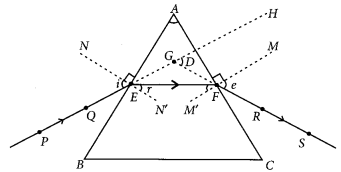
i = angle of incidence
(a) PE = incident ray
(b) FS = emergent ray
(c) ∠D = angle of deviation
Question 29.
Draw a ray diagram to explain the term angle of deviation. (1/5, Delhi 2017)
Answer:
The emergent ray bends at an angle to the direction of the’incident, thus the angle between them is known as angle of deviation (D).
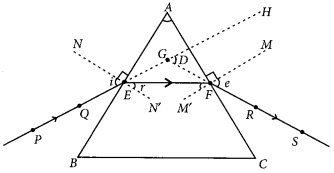
Question 30.
Draw a labelled diagram to explain the formation of a rainbow in the sky. (Foreign 2015)
Answer:
A rainbow is a natural spectrum caused by dispersion of sunlight by tiny water droplets, present in the atmosphere.
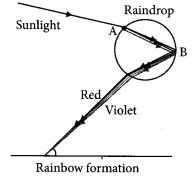
Point A denotes dispersion and point B denotes internal reflection.
Question 31.
How will you use two identical glass prisms so that a narrow beam of white light incident on one prism emerges out of the second prism as white light? Draw and label the ray diagram. (2020)
Answer:
Newton was the first to use a glass prism to obtain the spectrum of a white light. He then placed a second identical prism in an inverted position with respect to the first prism. This allowed all the colours of the white light to pass through the second prism combining to form a white light emerging from the other side of the second prism. This made him believe that white light was composed of different colours.
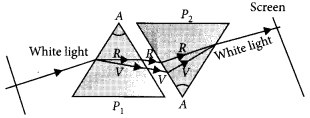
Question 32.
Differentiate between a glass slab and a glass prism. What happens when a narrow beam of
(i) a monochromatic light and (ii) white light passes through (a) glass slab and (b) glass prism? (2020)
Answer:
Glass slab:
- It is a substance made of glass having three dimension and has cuboidal structure.
- It does not deviate the path of light falling on it but produces a lateral displacement of the light ray after refraction. The incident and emergent ray are parallel to each other.
caused
- A prism is a structure made of glass with two triangle bases and three rectangular lateral surfaces. These surfaces are inclined to each other.
- A prism deviates the path of light ray falling on it. Here the incident ray and emergent ray are not parallel to each other.
(i) When a narrow beam of monochromatic light falls on a
(a) glass slab, it gets refracted at its surface and the emergent ray is laterally displaced from the incident ray.
(b) prism, it gets refracted at the surface and the light gets deviated from its initial path. The angle between the incident ray and emergent ray is known as angle of deviation.
(ii) When a white light passes through a
(a) glass slab, the light does not undergo dispersion as its two refracting surfaces are parallel to each other. The white light is laterally displaced from its initial path.
(b) prism, the white light undergoes dispersion and splits into its constituent colours along with deviation from its initial path.
Question 33.
(a) With the help of labelled ray diagram show the path followed by a narrow beam of monochromatic light when it passes through a glass prism.
(b) What would happen if this beam is replaced by a narrow beam of white light? (2020)
Answer:
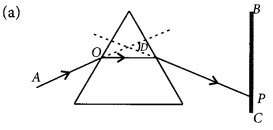
Here, in the figure, ∠D is the angle of deviation of the given monochromatic light by the glass prism.
(b) If AO were a ray of white light, then on screen BC, a spectrum will be observed, consisting of seven colours arranged from bottom to top as follows. Violet, Indigo, Blue, Green, Yellow, Orange, Red (VIBGYOR)
Question 34.
What is rainbow? Draw a labelled diagram to show the formation of a rainbow. (Delhi 2019)
Answer:
After a rain-shower, the sunlight gets dispersed by tiny droplets, present in the atmosphere. The water droplets acts like small glass prisms. They refract and disperse the incident sunlight, then reflect it internally, and finally refract it again when it comes out of the raindrop. Due to dispersion of light and internal reflection, different colours reaches the observers eye, which is called a rainbow.
Refer to answer 30.
Question 35.
What is ‘dispersion of white light’? State its cause. Draw a ray diagram to show the dispersion of white light by a glass prism. (AI 2017)
Answer:
Splitting of white light into its seven constituent colours due to refraction is known as dispersion of white light.
Cause of dispersion : When a beam of white light enters a prism, it gets refracted and splits into seven constituent colours. The splitting of the light ray occurs due to the different bending angle for each colour. Thus, each colour ray when passing through the prism bends at different angles with respect to the incident beam, thus giving rise to a spectrum.
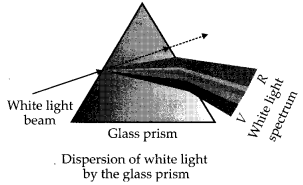
Question 36.
State the cause of dispersion of white light passing through a glass prism. How did Newton showed that white light of sun contains seven colours using two identical glass prisms. Draw a ray diagram to show the path of light when two identical glass prisms are arranged together in inverted position with respect to each other and a narrow beam of white light is allowed to fall obliquely on one of the focus of the first prism. (Delhi 2016)
Answer:
Refer to answer 35 and 31.
Question 37.
Describe an activity to show that the colours of white light splitted by a glass prism can be recombined to get white light by another identical glass prism. Also draw ray diagrams to show the recombination of the spectrum of white light. (AI 2016)
Answer:
Refer to answer 31.
Question 38.
A narrow PQ of white light is passing through a glass prism ABC as shown in the diagram. Trace it on your answer sheet and show the path of the emergent beam as observed on the screen DE.
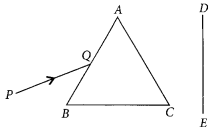
(i) Write the name and cause of the phenomenon observed.
(ii) Where else in nature is this phenomenon observed?
(iii) Based on this observation, state the conclusion which can be drawn about the constituents of white light. (AI 2014)
Answer:
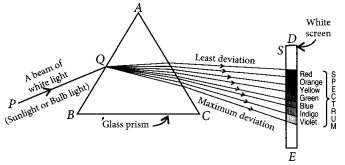
(i) The phenomenon of the splitting up of the white light into its constituents colours is called dispersion of light. Dispersion of light is caused due to, different constituents colours of light after different refractive indices to the material of the prism.
(ii) The formation of rainbow is caused by the dispersion of the white sunlight into its constituent colours.
(iii) Based on the dispersion of white light into its constituents colours, we can conclude that
(a) The white light consists of seven colours.
(b) The violet light Millers maximum deviations and the red light suffers minimum deviation.
Question 39.
Define the term dispersion of white light. Name the colour of light which bends (i) the most, (ii) the least while passing through a glass prism. Draw a ray diagram to justify your answer. (Foreign 2014)
Answer:
Refer to answer 38.
Question 40.
What is a spectrum? How can we recombine the components of white light after a glass prism has separated them? Illustrate it by drawing a diagram. (Foreign 2014)
Answer:
Refer to answer 36.
Question 41.
When we place a glass prism in the path of a narrow beam of white light, a spectrum is obtained. What happens when a second identical prism is placed in an inverted position with respect to the first prism? Draw a labelled diagram to illustrate it. (Delhi 2012)
Answer:
Refer to answer 31.
Question 42.
Draw a labelled ray diagram to illustrate the dispersion of a narrow beam of white light when it passes through a glass prism. (AI 2012)
Answer:
Refer to answer 35.
Question 43.
Draw a ray diagram to show the formation of a rainbow and mark the point where
(i) dispersion, (ii) internal reflection occurs. (Foreign 2012)
Answer:
Refer to answer 30.
Question 44.
What is meant by the dispersion of white light? Draw a diagram to show dispersion of white light by the glass prism. (Delhi 2011)
Answer:
Refer to answer 35.
Question 45.
Explain the formation of rainbow in the sky with the help of a diagram. (Foreign 2011)
Answer:
Refer to answer 30.
Question 46.
Give reasons:
(i) The extent of deviation of a ray of light on passing through a prism depends on the colour.
(ii) Lights of red colour are used for danger signals. (Foreign 2011)
Answer:
(i) The extent of deviation of a ray of light on passing through a prism depends on the colour because the refractive index of glass for different colour is different. It depends on wavelength of a particular light.
due
Question 47.
(a) Why do the component colours of incident white light split into a spectrum while passing through a glass prism, explain.
(b) Draw a labelled ray diagram to show the formation of a rainbow. (4/5, Delhi 2017)
Answer:
(a) When a beam of light incidents on a prism, it first gets refracted and splits into seven constituent colors. The splitting of the light ray occurs due to the different bending angle for each colour. Thus each colour ray when passing through the prism bends at different angles with respect to the incident beam. This gives rise to the formation of the spectrum.
to
Question 48.
(a) What is dispersion of white light? State its cause.
(b) “Rainbow is an example of dispersion of sunlight.” Justify this statement by explaining, with the help of a labelled diagram, the formation of a rainbow in the sky. List two essential conditions for observing a rainbow. (Foreign 2016)
Answer:
(a) Refer to answer 35.
(b) Refer to answer 34.
Two essential conditions for observing rainbow are
(i) Sun should be at the back of the observer.
(ii) Rainbow should be seen after rainfall or through a waterfall or water fountain.
Question 49.
(a) Trace on your answer sheet the path of a monochromatic ray AO incident on a glass prism and mark the angle of deviation.
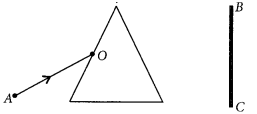
(b) If AO were a ray of white light,
(i) describe what will you observe on the screen BC placed near the prism
(ii) write the name of this phenomenon
(iii) state the cause of this phenomenon
(iv) what does it prove about the constituents of white light? (Delhi 2013 C)
Answer:
(a) Refer to answer 33(a)
(b) (i) Refer to answer 33(b)
(ii) This phenomenon is known as dispersion of light.
(iii) Refer to answer 35.
(iv) It proves that a white light consists of seven colours and lower the wavelength higher will be the deviation of light.
Question 50.
Why do stars appear to twinkle ? Explain. (Foreign 2015)
Answer:
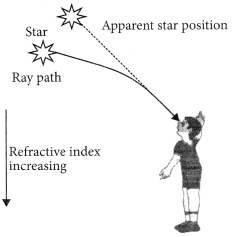
gradual
Question 51.
Explain why the planets do not twinkle. (Foreign 2015)
Answer:
Planets do not emit light. However, they become visible due to reflection of light falling on them. The planets are much closer to the earth and thus can be considered as the extended source of light. The fluctuations in the light coming from various points of the planet due to atmospheric refraction get averaged out. As a result, no twinkling of planets is seen.
Question 52.
Explain in brief the reason for each of the following:
(a) Advanced sun-rise
(b) Delayed sun-set
(c) Twinkling of stars (Foreign 2016)
Answer:
(a, b): The Sun is visible to us about 2 minutes before the actual sunrise, and about 2 minutes after the actual sunset because of atmospheric refraction. By actual sunrise, we mean the actual crossing of the horizon by the Sun. Figure shows the actual and apparent positions of the Sun with respect to the horizon. The time difference between actual sunset and the apparent sunset is about 2 minutes. The apparent flattening of the Sun’s disc at sunrise and sunset is also due to the same phenomenon.
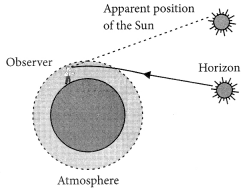
weakening
Question 53.
What is meant by advance sunrise and delayed sunset? Draw a labelled diagram to explain these phenomena. (Foreign 2015)
Answer:
Refer to answer 52(a) and (b).
Question 54.
Explain with the help of a labelled diagram, the cause of twinkling of stars. (Delhi 2014)
Answer:
Refer to answer 50.
Question 55.
A star sometimes appears brighter and some other times fainter. What is this effect called? State the reason for this effect. (Delhi 2012)
Answer:
This effect is called twinkling of stars.
Refer to answer 50.
Question 56.
A star appears slightly higher (above) than its actual position in the sky. Illustrate it with the help of a labelled diagram. (AI2012)
Answer:
A star appears slightly above than its actual position in the sky. Since the starlight, on entering the earth’s atmosphere undergoes refraction continuously in a medium of gradually changing refractive index, before it reaches the earth. Since the atmosphere bends starlight towards the normal, the star appears slightly above than its actual position.
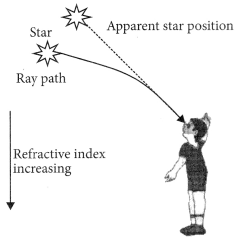
Question 57.
“The time difference between the actual sunset and the apparent sunset is about 2 minutes” What is the reason for the same? Explain with the help of a diagram. (Foreign 2012)
Answer:
Refer to answer 52(a) and (b).
Question 58.
Explain why the planets do not twinkle but the stars twinkle. (Delhi 2011)
Answer:
Refer to answer 50 and 51.
Question 59.
Why do stars twinkle ? Explain (2/3, 2018)
Answer:
Refer to answer 50.
Question 60.
What is atmospheric refraction? Use this phenomenon to explain the following natural events.
(a) Twinkling of stars
(b) Advanced sun-rise and delayed sun-set. Draw diagrams to illustrate your answers. (AI 2016)
Answer:
Refraction of the light by the different layers of the atmosphere having different refractive indices is known as atmospheric refraction.
(a) Twinkling of stars : Refer to answer 50.
(b) Advanced sun-rise and delayed sun-set : Refer to answer 52(a) and (b).
Question 61.
The sky appears dark to passengers flying at very high altitudes mainly because
(a) Scattering of light is not enough at such heights.
(b) There is no atmosphere at great heights.
(c) The size of molecules is smaller than the wavelength of visible light.
(d) The light gets scattered towards the earth. (2020)
Answer:
(b) There is no atmosphere at great heights.
Question 62.
Consider the following reasons for the reddish appearance of the sun at the sunrise or the sunset:
(A) Light from the sun near the horizon passes through thinner layers of air.
(B) Light from the sun covers larger distance of the earths atmosphere before reaching our eyes.
(C) Near the horizon, most of the blue light and shorter wavelengths are scattered away by the particles.
(D) Light from the sun near the horizon passes through thicker layers of air.
The correct reasons are
(a) A and C only
(b) B, C and D
(c) A and B only
(d) C and D only (2020)
Answer:
(b) Near the horizon, the light rays from the sun has to travel a larger distance through the Earth’s atmosphere as compared to when it is away from the horizon. Thus, when this light travels through the atmosphere, most of short wavelength lights are scattered away causing the reddish appearance of the sun.
Question 63.
What will be the colour of the sky when it is observed from a place in the absence of any atmosphere? (Delhi 2012)
Answer:
If the earth had no atmosphere, there would not have been any scattering. Then, the sky would look dark.
Question 64.
Give an example of a phenomenon where Tyndall effect can be observed. (AI 2011)
Answer:
The phenomenon of scattering of light by the colloidal particle give rise to Tyndall effect.
This phenomenon is seen when a fine beam of sunlight enters a smoke-filled room through a small hole. This can also be observed when sunlight passes through a canopy of a dense forest.
Question 65.
Why is the colour of clear sky blue? (Foreign 2011)
Answer:
When sunlight passes the atmosphere, the fine particles in air scatter blue colour more strongly than red. This scattered blue light enters our eye and the colour of clear sky appears blue.
Question 66.
Why is Tyndall effect shown by colloidal particles? State four instance of observing the Tyndall effect. (2020)
Answer:
The phenomenon of scattering of light by the colloidal particles give rise to Tyndall effect. When a beam of light strike colloidal particles, the path of the beam becomes visible. This is known as Tyndall effect.
of
- sunlight passes through a canopy of dense forest, when tiny water droplets in the mist scatter light.
- torch light is switched on in a foggy environment, light rays are visible after being scattered by the fog particles in the surrounding air.
- a fine beam of sunlight enters a smoke-filled room through a small hole.
- shining a flashlight beam into a glass of dilated milk produces Tyndall effect.
Question 67.
Draw a labelled diagram to show (i) reddish appearance of the sun at the sunrise or the sunset and (ii) white appearance of the sun at noon when it is overhead. (2020)
Answer:
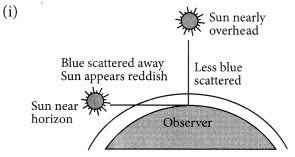
At sun-rise and the sun-set, light from the sun passes through thicker layers of air and larger distance in the earth’s atmosphere. As the red colour has longest wavelength hence, it is least scattered by the air and dust particles. So, the sun appears reddish.
ciliary
Question 68.
(a) State the relation between colour of scattered light and size of the scattering particle.
(b) The apparent position of an object, when seen through the hot air, fluctuates or waves. State the basic cause of this observation.
(c) Complete the path of white light when it passes through two identical prisms placed as shown
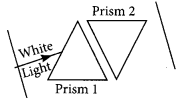
Answer:
(a) The colour of scattered light depends on the size of the scattering particle. Very fine particles scatter short wavelengths such as blue and violet, lights. Large size particles scatter light of longer wavelengths.
muscles
.
Question 69.
With the help of a labelled diagram, explain why the sun appears reddish at the sun-rise and the sun-set. (Delhi 2015)
Answer:
Refer to answer 67(i).
Question 70.
What is meant by scattering of light? Use this phenomenon to explain why the clear sky appears blue or the sun appears reddish at sunrise. (AI 2015)
Answer:
The phenomenon by which a beam of light is redirected in many different directions when it interacts with a particle of matter is known as scattering of light.
Refer to answer 65 and 67(i).
Question 71.
Explain giving reason why the sky appears blue to an observer from the surface of the Earth. What should the appearance of the sky be during the day for an astronaut staying in the international space station orbiting the Earth? State reason to justify your answer. (Foreign 2015)
Answer:
Refer to answer 65.
For an astronaut staying in the international space station orbiting the Earth, the appearance of the sky will be black due to absence of air molecules to scatter the light coming from the Sun.
Question 72.
State the difference in colours of the sun observed during sunrise/sunset and noon. Give explanation for each. (Delhi 2013)
Answer:
During sunrise or sunset, the suns rays pass through a maximum length of the atmosphere. Most of the blue and shorter wavelength get scattered. Only the red colour of light reaches the observer. That is why the Sun observed during sunset and sunrise appear red. At noon, the distance to be travelled is least. All wavelengths are scattered equally and hence sun appears white.
Question 73.
Why does the sun appear reddish early in the morning? Will this phenomenon be observed by an astronaut on the Moon? Give reason to justify your answer. (3/5, 2018)
Answer:
Refer to answer 67(i).
This phenomenon cannot be seen by an astronaut on the moon because there is no atmosphere on moon to scatter the light.